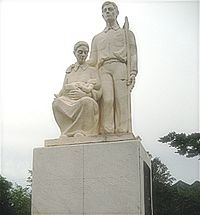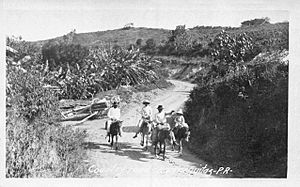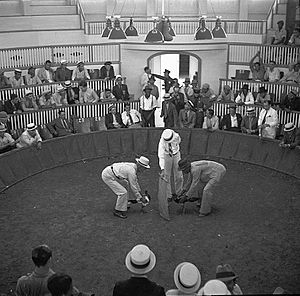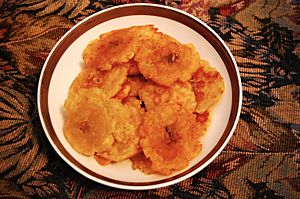Jíbaro (Puerto Rico) facts for kids
Quick facts for kids
Jíbaro
|
|
|---|---|

Monumento al Jíbaro Puertorriqueño dedicated to the jíbaro, in Salinas, Puerto Rico
|
|
| Nationality | Puerto Rican |
| Occupation | Self-subsistence farmers, agricultural land tenants, sharecroppers, fieldworkers |
A Jíbaro (pronounced hee-VAH-roh) is a special word used in Puerto Rico. It describes people from the countryside who traditionally farm the land. Jíbaros were often farmers who grew just enough food for their families to eat. They also grew extra crops to sell in nearby towns. This helped them buy things their families needed, like clothes.
The jíbaro is a very important symbol of the Puerto Rican people. Today, many Puerto Ricans, no matter their job, proudly call themselves jíbaros. It connects them to their history and culture.
Contents
A Look Back in Time
As early as 1820, a writer named Miguel Cabrera wrote poems about the jíbaro's ideas and traits. Later, in 1898, Robert Thomas Hill wrote about different groups of people in Puerto Rico. He listed jíbaros as one of these groups, describing them as "the lower class of white peasantry."
In the mid-1900s, Puerto Rico changed a lot. A big plan called "Operation Bootstrap" helped the island shift from farming to factories. Many jíbaros moved from their mountain homes to bigger cities to find work in these new industries.
Jíbaros had a huge impact on Puerto Rican culture, politics, and even language. People had different ideas about what a jíbaro meant.
Jíbaros and Politics
When Luis Muñoz Marín ran for office, he often talked about the jíbaro. He used the jíbaro image to bring together working-class people in Puerto Rico. He wanted to show them as hard-working Puerto Ricans.
Muñoz Marín even chose the outline of a Puerto Rican farmer wearing a pava (a straw hat) as his political party's symbol. This hat was often worn by farm workers. It helped show the jíbaro as a proud person who worked hard on the land. His party's motto was "Pan, Tierra, Libertad" (Bread, Land, Liberty). Muñoz Marín sometimes even dressed like a jíbaro to connect with voters. By making the jíbaro seem like an ideal person, he also got the support of many important cultural leaders.
In 1941, Oscar Colón Delgado created a drawing called Jíbaro Negro (black jíbaro), showing a dark-skinned jíbaro farmer. Later, a singer named Andrés Jiménez, "el Jíbaro" sang about "El Puertorriqueño" having a dark skin tone, helping to change how people saw the jíbaro.
Life and Values

The jíbaro way of life is often linked to the rich history and positive culture of Puerto Rico. It shows the true spirit, cleverness, and skill of the Puerto Rican people. Their values include a strong sense of community, family, and being welcoming to others.
Children learned early to help their families. For example, they helped clean and cook meals. Older children learned to iron their own clothes and polish their shoes. Some kids were encouraged to find ways to earn money for things that weren't "needs." Important values taught were respect for hard work, being resourceful, and understanding the importance of being united, determined, and honest.
A report from 1930 described the jíbaro as "kindly, friendly and courteous, and hospitable to the last degree." It said a jíbaro would invite you in, offer you coffee, give you their bed, and take care of your horse, refusing any payment.
Music of the Jíbaro

Jíbaro culture also has its own special folk music, often called "jíbaro music." This music was the main way mountain people, who worked on coffee farms and other farms, expressed themselves. This type of music is also known as typical music, mountain music, or peasant music.
Ramito is known as one of the greatest singers of jíbaro music. Odilio González, another jíbaro music singer from the mountain town of Lares, even used the stage name "El Jíbarito de Lares" (the little Jíbaro from Lares).
Jíbaro music uses the cuatro as its main instrument. It also features the guitar and güiro. Other instruments like Maracas, bongos, congas, and cowbells are often used too.
There are three main types of jíbaro music:
Today, jíbaro music is heard most often during the Christmas season. But it's also played at weddings, birthdays, and local town festivals called fiestas patronales throughout the year.
Jíbaro Food
Plantains were a very important food for the jíbaro, like "daily bread." Ripe plantains could be eaten like bread, and unripe ones could be roasted or baked. Many other foods come from plantains, such as mofongo, maduros, and tostones. Plantains are also a key ingredient in pasteles.
Much of what people think of as real Puerto Rican food today actually came from the dishes jíbaros made in the countryside. Jíbaros cooked their food using stone stoves and grilling on sticks (called a la varita).
Some common traditional dishes include asopao (a thick soup with rice and chicken), pasteles, and mofongo. Some jíbaro songs mention them eating "viandas and bacalao" (root vegetables and codfish) as a daily meal. When jíbaros moved to coastal towns, their food changed a bit. For example, asopao was also made with seafood instead of chicken.
Jíbaro Language
An old document from 1887 talks about a "jíbaro language." It mentions a document "written in jíbaro which has not been possible to decipher." This shows that jíbaros might have had their own unique way of speaking or writing.
Traditional Clothing
Jíbaro men traditionally wore a long-sleeved white shirt, white pants, a hat without fringes, and no shoes. Jíbaro women (called "jíbaras") usually dressed in white too, with a long shirt that covered their shoulders and neck. They sometimes wore a hat or a bandana on their heads. They also usually didn't wear shoes. Not wearing shoes was not a sign of being poor. Many photos show jíbaros dressed well but without shoes, suggesting it was for comfort. Young jíbaro boys were sometimes seen without clothes at home, even when guests were visiting.
Entertainment

A very popular form of entertainment for jíbaros was cock-fighting. These events usually happened on Sunday afternoons. But holidays or special feast days would bring out even bigger crowds. Every town in Puerto Rico had at least one place for cock-fighting. Richer people sometimes watched, but they usually didn't take part. Unlike in some other places where roosters had sharp metal blades on their legs, Puerto Rican jíbaros used their own natural spurs (called gaffs).
Jobs and Work
Many jíbaros were farmers who grew food for themselves. But some didn't own land. They worked as tenants (renting land), sharecroppers (sharing crops with the landowner), or fieldworkers. Those who owned land sometimes grew extra crops to sell in towns. They grew whatever the land would produce, like bananas, plantains, avocados, yams, and other root vegetables. They also traded hens, eggs, and charcoal.
Fighting for Freedom
Jíbaros were a big part of many fights against the rulers of the island. They were the main force behind revolutions against the Spanish, like the famous 1868 Grito de Lares (Cry of Lares). Even after that revolution failed, jíbaros kept the idea of Puerto Rican freedom alive through other revolts, including the 1897 Intentona de Yauco.
When Americans took over Puerto Rico in 1898, many jíbaros formed "Seditious Bands" to protest American rule. They continued this fight through armed clashes in the 1930s and a big revolt in 1950.
Jíbaro Today
Since at least the 1920s, the word "jíbaro" has become more positive in Puerto Rican culture. It's now linked to a proud heritage passed down from the first brave settlers of Puerto Rico's mountains and countryside.
Sometimes, the word can still have a negative meaning, like someone who isn't formally educated. But mostly, the jíbaro is seen as a "traditional Puerto Rican": simple but hard-working, independent, and wise. The jíbaro image represents the roots of modern Puerto Ricans and shows the strength of traditional values like living simply and taking good care of family and the homeland.
Jíbaro in Other Countries
- In Cuba, there's a similar word, Guajiro.
- In Colombia, Brazil, and Venezuela, a similar-sounding word, Xivaro or Gibaro, was used by the Spanish and Portuguese for mountain natives.
- In Ecuador, "givaro" refers to independent native or country people who are hard for outsiders to control.
See also
 In Spanish: Jíbaro para niños
In Spanish: Jíbaro para niños
- Jibarito
- Yomo Toro
- Cachi Cachi music
- La Carreta
- Machuchal



